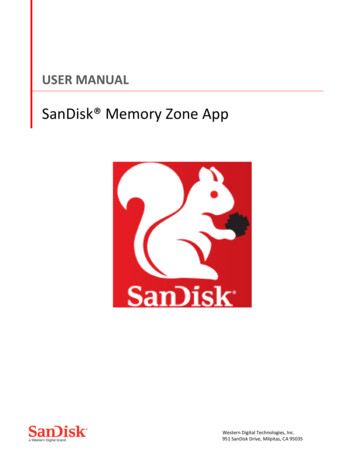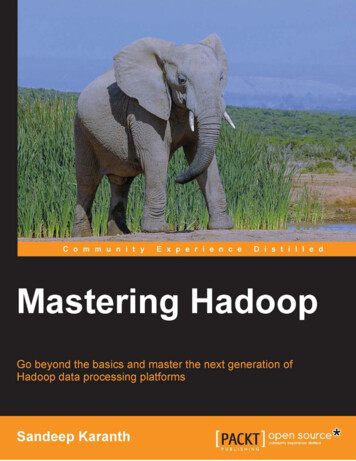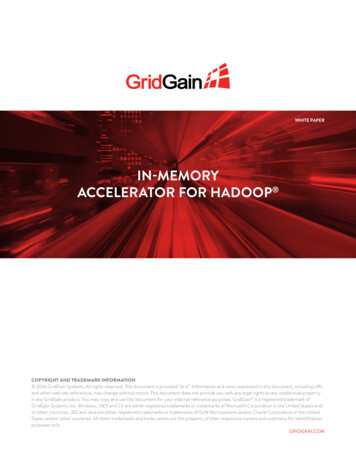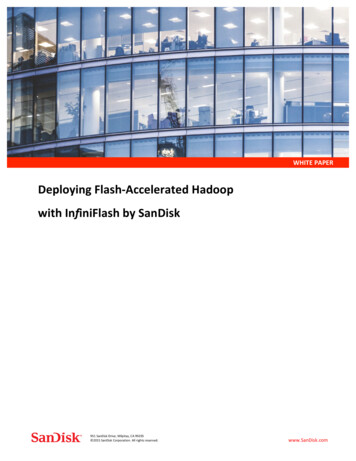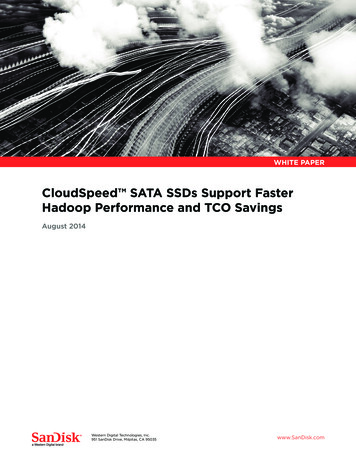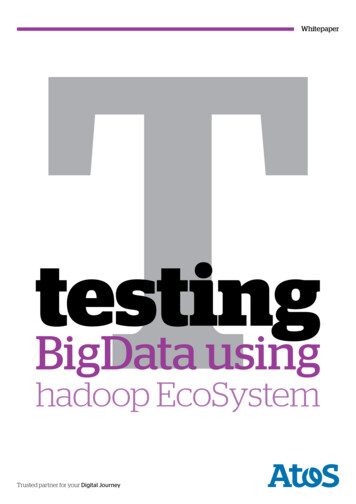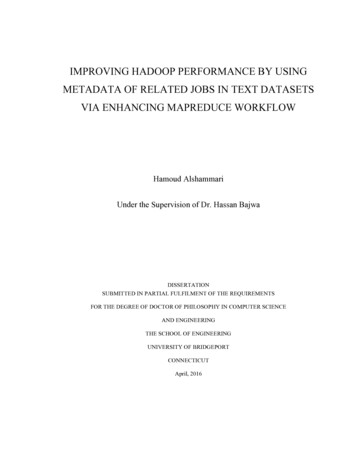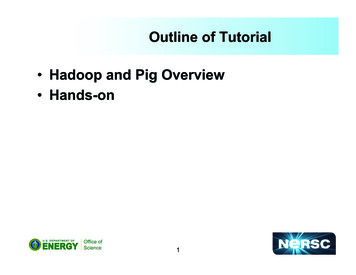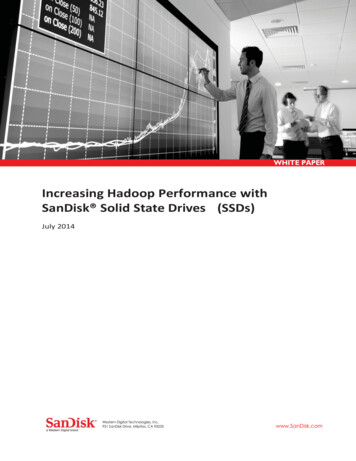
Transcription
WHITE PAPERIncreasing Hadoop Performance withSanDisk Solid State Drives (SSDs)July 2014Western Digital Technologies, Inc.951 SanDisk Drive, Milpitas, CA 95035www.SanDisk.com
Increasing Hadoop Performance with SanDisk Solid State Drives (SSDs)Table of Contents1. Executive Summary . 32. Apache Hadoop . 43. Hadoop and SSDs . 44. Terasort Benchmark . 55. Test Design. 56. Test Environment . 67. Technical Component Specifications . 7Hardware . 7Software . 78. Compute Infrastructure . 79. Network Infrastructure. 810. Storage Infrastructure . 811. Cloudera Hadoop Configuration . 912. Operating System Configuration . 913. Test Validation . 10Test Methodology . 1014. Results Summary . 1215. Results Analysis . 13Performance Analysis . 1316. TCO Analysis (Cost/Job Analysis) . 1417. Conclusions . 1618. References . 172
Increasing Hadoop Performance with SanDisk Solid State Drives (SSDs)1. Executive SummaryThis technical paper describes 1TB Terasort testing conducted on a Big Data/Analytics Hadoopcluster using SanDisk solid-state drives (SSDs). The goal of this paper is to show the benefits of usingSanDisk SSDs within a scale-out Hadoop cluster environment.SanDisk’s CloudSpeed Ascend SATA SSDs product family was designed specifically to address thegrowing need for SSDs that are optimized for mixed-use application workloads in enterprise serverand cloud computing environments. CloudSpeed Ascend SATA SSDs offer all the features expectedfrom an enterprise drive, and support accelerated performance at a good value.CloudSpeed Ascend SATA SSDs provide a significant performance improvement when runningI/O-intensive workloads, especially with a mixed-use application that has random read and randomwrite data access, compared with what is traditional sequential read and write data access withspinning HDDs. On a Hadoop cluster, this performance improvement directly translates into fasterjob completion, therefore better utilization of the Hadoop cluster. This performance improvementhelps to reduce the cluster footprint by using fewer cluster nodes, therefore reducing the total cost ofownership (TCO).For over 25 years, SanDisk has been transforming digital storage with breakthrough products andideas that push the boundaries of what’s possible. SanDisk flash memory technologies are used bymany of the world’s largest data centers today. For more information visit: www.sandisk.com.Summary of Flash-enabled Hadoop Cluster Testing: Key FindingsSanDisk tested a Hadoop cluster using the Cloudera Distribution of Hadoop (CDH). This clusterconsisted of one (1) NameNode and six (6) DataNodes, which was set up for the purpose ofdetermining the benefits of using SSDs within a Hadoop environment, focusing on the Terasortbenchmark.SanDisk ran the standard Hadoop Terasort benchmark on different cluster configurations. The testsrevealed that SSDs can be deployed strategically in Hadoop environments to provide significantperformance improvement (1.4x-2.6x for the Terasort benchmark)1 and TCO benefits (22%-53%reduction in cost/job for the Terasort benchmark)2 to organizations that deploy them. In summary,these tests showed that the SSDs are beneficial for Hadoop environments that are storage-intensiveand that see a very high proportion of random access to the storage. This technical paper discussesthe Terasort tests on a flash-enabled cluster, and provides a proof-point for SSD performance andSSD TCO benefits within the Hadoop ecosystem.We should note that the runtime for the Terasort benchmark for a 1TB dataset was recorded forthe different configurations. The results of these runtime tests are summarized and analyzed inthe Results Summary and Results Analysis sections. Based on these tests, this paper also includesrecommendations for using SSDs within a Hadoop configuration.1Please refer to results shown in Figure 3.Please refer to results shown in Figure 4.23
Increasing Hadoop Performance with SanDisk Solid State Drives (SSDs)2. Apache HadoopApache Hadoop is a framework that allows for the distributed processing of large datasets acrossclusters of computers using simple programming models. It is designed to scale up from a singleserver to several thousands of servers, with each server offering local computation and storage.Rather than relying on the uptime for any single hardware device to deliver high availability, Hadoopis designed to detect and handle failures at the application layer, thus delivering a highly availableservice on top of a cluster of computers, each of which may be prone to failures.Hadoop Distributed File System (HDFS) is the distributed storage used by Hadoop applications. AHDFS cluster consists of a NameNode that manages the file system metadata, and DataNodes thatstore the actual data. Clients contact the NameNode for file metadata or file modifications and theyperform actual file I/O operations directly with DataNodes.Hadoop MapReduce is a software framework for easily writing applications that process vastamounts of data (multi-terabyte data-sets) in parallel on large Hadoop clusters (with thousands ofnodes) of commodity hardware in a reliable, fault-tolerant manner. A MapReduce job usually splitsthe input data-set into independent chunks that are processed by the Map tasks in a completelyparallel manner. The framework sorts the outputs of the Maps, which are then input to the Reducetasks. Typically, both the input and output of a MapReduce job are stored on the HDFS. Theframework takes care of scheduling tasks, monitoring them and re-executing the failed tasks. TheMapReduce framework consists of a single master JobTracker and one slave TaskTracker per clusternode. The master is responsible for scheduling the jobs’ component tasks on the slaves, monitoringthem and re-executing the failed tasks. The slaves then execute tasks as directed by the master.3. Hadoop and SSDsTypically, Hadoop environments use commodity servers, with SATA HDDs as local storage on clusternodes. However, SSDs, when used strategically within a Hadoop environment, can likely providesignificant performance benefits.Hadoop workloads have a lot of variation in terms of their storage access profiles. Some Hadoopworkloads are compute-intensive, some are storage-intensive and some are in between. ManyHadoop workloads use custom datasets and customized MapReduce algorithms to execute veryspecific analysis tasks on the datasets.SSDs in Hadoop environments will benefit storage-intensive datasets and workloads, especiallythose with a very high proportion of random I/O access. Additionally, Hadoop MapReduce workloadsshowing significant random storage accesses during the intermediate phases (shuffle/sort phasesbetween the Map and Reduce phases) will also see performance improvements when using SSDs forthe intermediate data accesses.This technical paper discusses one such workload benchmark called Terasort.4
Increasing Hadoop Performance with SanDisk Solid State Drives (SSDs)4. Terasort BenchmarkTerasort is a standard Hadoop benchmark. It is an I/O-intensive workload that sorts a very largeamount of data using the MapReduce paradigm. The input and output data are stored on HDFS.Terasort benchmark consists of the following components:1.Teragen: This component generates the dataset for the benchmark. The dataset is in the form ofkey-value pairs generated randomly.2.Terasort: This component performs the sorting based on the keys in the dataset.3.Teravalidate: This component is used to validate the result of Terasort.The testing discussed in this technical paper primarily focuses on Teragen and Terasort.In order to start Teragen on a 1TB dataset, one should execute the following command as user ‘hdfs’with the size of the dataset and the input directory as parameters. Note that the size of the dataset isprovided as a parameter and is counted in multiples of 100 bytes:# hadoop jar ib/hadoop-mapreduce/hadoop-mapreduce-examples.jar teragen 10000000000 /user/sort-inTo start Terasort, use the following command, giving as input the input directory used by Teragen andthe output directory to write the sorted data:# hadoop jar ib/hadoop-mapreduce/hadoop-mapreduce-examples.jar terasort /user/sort-in /user/sort-out.5. Test DesignA Hadoop cluster using the Cloudera Distribution of Hadoop (CDH) consisting of one (1) NameNodeand six (6) DataNodes associated with the HDFS file system was set up for the purpose ofdetermining the benefits of using SSDs within a Hadoop environment, focusing on the Terasortbenchmark. The testing consisted of using the standard Hadoop Terasort benchmark on differentcluster configurations (described in the Test Methodology section). The runtime for the Terasortbenchmark doing the sort on a 1TB dataset was recorded for the different configurations. Theresults of these runtime tests are summarized and analyzed in the Results Summary and ResultsAnalysis sections. And finally, the paper ends with recommendations for using SSDs within a Hadoopconfiguration.5
Increasing Hadoop Performance with SanDisk Solid State Drives (SSDs)6. Test EnvironmentThe test environment consisted of one (1) Dell PowerEdge R720 server being used as a NameNodefor a Hadoop cluster with six (6) Dell PowerEdge R320 servers being used as DataNodes withinthis cluster. A 10GbE private network interconnect was used on all of the servers within the Hadoopcluster for Hadoop communication. Each of the nodes also used a 1GbE management network. Thelocal storage was varied, depending on the type of test configuration (HDDs or SSDs).Figure 1. shows a pictorial view of the test environment, which is followed by a chart describing thehardware and software components that were used within the test environment.Hadoop Cluster Topology1 x Namenode1 x JobTrackerDell PowerEdge R720 2 x 6-core Intel Xeon E5-2620 @ 2 GHz 96GB memory 1.5TB RAIDS HDD local storageDell PowerConnect 8132F 10 GbE network switch For private Hadoop network6 x DataNodes6 x TasktrackersDell PowerEdge R320s, each has 1 x 6-core Intel Xeon ES-2430 2.2 GHz 16GB memory 2 x 500GB HDDs 2 x 480GB CloudSpeed SSDsFigure 1.: Cloudera Hadoop Cluster Environment6
Increasing Hadoop Performance with SanDisk Solid State Drives (SSDs)7. Technical Component SpecificationsHardwareHardwareSoftware if applicablePurposeQuantityDell PowerEdge R320 1 x Intel Xeon E5-2430 2.2 GHz,6 core CPU, hyper-threaded 16GB memory HDD Boot drive RHEL 6.4Cloudera Distribution of Hadoop 4.4.0DataNodes6Dell PowerEdge R720 2x Intel Xeon E5-2620 2 Ghz 6 coreCPUs 96GB memory SSD boot drive RHEL 6.4Cloudera Distribution of Hadoop 4.4.0Cloudera Manager 4.8.1NameNode, SecondaryNameNode1Dell PowerConnect 2824 24-port switch1 GbE network switchManagement network1Dell PowerConnect 8132F 24-port switch10 GbE network switchHadoop data network500GB 7.2K RPM Dell SATA HDDsUsed as Just a bunch of disks (JBODs)DataNode drives12480GB CloudSpeed Ascend SATA SSDsUsed as Just a bunch of disks (JBODs)DataNode drives12Dell 300GB 15K RPM SAS HDDsUsed as a single RAID 5 (5 1) groupNameNode drives61Table 1.: Hardware componentsSoftwareRed Hat Enterprise Linux6.4Operating system for DataNodes and NameNodeCloudera Manager4.8.1Cloudera Hadoop cluster administrationCloudera Distribution of Hadoop (CDH)4.4.0Cloudera’s Hadoop distributionTable 2.: Software components8. Compute InfrastructureThe Hadoop cluster NameNode is a Dell PowerEdge R720 server with two hex-core Intel Xeon E52620 2 GHz CPU (hyper-threaded) and 96GB of memory. This server has a single 300GB SSD thatwas used as a boot drive. The server had dual power-supplies for redundancy and high-availabilitypurposes.The Hadoop cluster DataNodes included six (6) Dell PowerEdge R320 servers, each with one (1) hexcore Intel Xeon E5-2430 2.2 GHz CPUs (hyper-threaded) and 16GB of memory. Each of these servershad a single 500GB 7.2K RPM SATA HDD that was used as a boot drive. The servers have dual powersupplies for redundancy and high-availability purposes.7
Increasing Hadoop Performance with SanDisk Solid State Drives (SSDs)9. Network InfrastructureAll cluster nodes (NameNode and all DataNodes) were connected to a 1GbE management networkvia the onboard 1GbE NIC. All cluster nodes were also connected to a 10GbE Hadoop cluster networkwith an add-on 10GbE network interface card (NIC). The 1GbE management network was connectedto a Dell PowerConnect 2824 24-port 1GbE switch. The 10GbE cluster network was connected to aDell PowerConnect 8132F 10GbE switch.10. Storage InfrastructureThe NameNode used six (6) 300GB 15K RPM SAS HDDs in RAID5 configuration for the HDFS. ThisNameNode setup was used across all the different testing configurations. The RAID5 logical volumewas formatted as an ext4 file system and was mounted for use by the Hadoop NameNode.Each DataNode had one of the following storage environments, as listed below, depending onthe configuration being tested. The specific configurations are discussed in detail in the TestMethodology section of this paper:1.2 x 500GB 7.2K RPM Dell SATA HDDs, OR2.2 x 480GB CloudSpeed Ascend SATA SSDs, OR3.2 x 500GB 7.2K RPM Dell SATA HDDs and 1 x 480GB CloudSpeed Ascend SATA SSDIn each of the above environments, the disks were used in a JBOD configuration.8
Increasing Hadoop Performance with SanDisk Solid State Drives (SSDs)11. Cloudera Hadoop ConfigurationConfiguration parameterValuePurposedfs.namenode.name.dir (NameNode)/data1/dfs/nn/data1 is mounted on theRAID5 logical volume on theNameNode.dfs.datanode.data.dir (DataNode)/data1/dfs/dn, /data2/dfs/dn Comma-delimited list of directories on the localNote: /data1 and /data2 are file system where the DataNode stores HDFS blockmounted on HDDs or SSDs, data.depending on which storageconfiguration is used.mapred.job.reuse.jvm.num.tasks-1Number of tasks to run per Java Virtual Machine(JVM). If set to -1, there is no limit.mapred.output.compressEnabledCompress the output of MapReduce jobs.MapReduce Child Java MaximumHeap Size512MBThe maximum heap size, in bytes, of the Javachild process. This number will be formatted andconcatenated with the 'base' setting for 'mapred.child.java.opts' to pass to Hadoop.mapred.taskstracker.map.tasks.maximum12The maximum number of map tasks that aTaskTracker can run imum6The maximum number of reduce tasks that aTaskTracker can run simultaneously.mapred.local.dir (job tracker)/data1/mapred/jt, /data1is mounted on the RAID5logical volume on theNameNode.Directory on the local file system where theJobTracker stores job configuration data.mapred.local.dir (task tracker)/data1/mapred/localList of directories on the local file system where aOR /ssd1/mapred/local,TaskTracker stores intermediate data files.depending on which storageconfiguration is used in thecluster.Determines where on the local file system theNameNode should store the name table (fsimage).Table 3.: Cloudera Hadoop configuration parameters12. Operating System ConfigurationThe following configuration changes were made to the Red Hat Enterprise Linux (RHEL) 6.4operating system parameters.1.As per Cloudera recommendations, swapping factor on the operating system was changed to20 from the default of 60 to avoid unnecessary swapping on the Hadoop DataNodes. This canalso be changed to 0 to completely switch off swapping (in this mode, swapping happens only ifabsolutely necessary for the OS operation).# sysctl -w vm.swappiness 209
Increasing Hadoop Performance with SanDisk Solid State Drives (SSDs)2.3.All file systems related to the Hadoop configuration were mounted via /etc/fstab with the‘noatime‘ option as per Cloudera recommendations. For example, for one of the configurations, /etc/fstab had the following entries./dev/sdb1/data1ext4noatime0 0/dev/sdc1/data2ext4noatime0 0/dev/sdd1/ssd1ext4noatime0 0The open files limit was changed from 1024 to 16384, per Cloudera recommendations. Thisrequired updating /etc/security/limits.conf as below,* Soft nofile 16384* Hard nofile 16384And /etc/pam.d/system-auth, /etc/pam.d/sshd, /etc/pam.d/su, /etc/pam.d/login were updated toinclude:session include system-auth13. Test ValidationTest MethodologyThe goal of this technical paper is to showcase the benefits of using SSDs within a Hadoopenvironment. To achieve this goal, SanDisk tested three separate configurations of the Hadoopcluster with the standard Terasort Hadoop benchmark on a 1TB dataset. The three configurations aredescribed in detail as follows. Note that there is no change to the NameNode configuration and itremains the same across all configurations.1.All-HDD configurationThe Hadoop DataNodes use HDDs for the HDFS, as well as Hadoop MapReduce.a. Each DataNode has two HDDs set up as JBODs. The devices were partitioned with a singlepartition and were formatted as ext4 file systems. These were then mounted in /etc/fstab to /data1 and /data2 with the noatime option. /data1 and /data2 were then used within the Hadoopconfiguration for DataNodes (dfs.datanode.data.dir) and /data1 was used for task trackersdirectories (mapred.local.dir).10
Increasing Hadoop Performance with SanDisk Solid State Drives (SSDs)2.HDD with SSD for intermediate dataIn this configuration, Hadoop DataNodes used HDDs as in the first configuration, along with a singleSSD which was used in the MapReduce configuration, as explained below.a. Each DataNode has two HDDs setup as JBODs. The devices were partitioned with a singlepartition, and then were formatted as ext4 file systems. These were then mounted in /etc/fstabto /data1 and /data2 with the noatime option. /data1 and /data2 were then used within theHadoop configuration for the nodes directories (dfs.datanode.data.dir).b. In addition to the HDDs being used on the DataNodes, there was also a single SSD on eachDataNode, which was partitioned with a 4K-divisible boundary via fdisk (shown below) andthen formatted to have ext4 file system.[root@hadoop2 ]# fdisk -S 32 -H 64 /dev/sddWARNING: DOS-compatible mode is deprecated. It’s strongly recommended to switch off themode (command ‘c’) and change display units to sectors (command ‘u’).Command (m for help): cDOS Compatibility flag is not setCommand (m for help): uChanging display/entry units to sectorsCommand (m for help): nCommand actione extendedp primary partition (1-4)pPartition number (1-4): 1First sector (2048-937703087, default 2048):Using default value 2048Last sector, sectors or size{K,M,G} (2048-937703087, default 937703087):Using default value 937703087Command (m for help): wThe partition table has been altered!Calling ioctl() to re-read partition table.Syncing disks.This SSD was then mounted in /etc/fstab as /ssd1 with the noatime option. This SSD was used in theshuffle/sort phase of MapReduce by updating the mapred.local.dir configuration parameter withinthe Hadoop configuration. The shuffle/sort phase is the intermediate phase between the Map phaseand the Reduce phase and it is typically I/O- intensive, with a significant proportion of randomaccess. SSDs show their maximum benefit in Hadoop configurations with this kind of random I/Ointensive workloads, and therefore this configuration was relevant to this testing.11
Increasing Hadoop Performance with SanDisk Solid State Drives (SSDs)3.All-SSD configurationIn this configuration, the HDDs of the first configuration were swapped out to all SSDs.a. Each DataNode had two (2) SSDs set up as JBODs. The devices were partitioned with asingle partition with a 4K divisible boundary (as shown in configuration 2 details above) andthen were formatted as ext4 file systems. These were then mounted in /etc/fstab to /data1and /data2 with the noatime option. /data1 and /data2 are then used within the Hadoopconfiguration for DataNodes (dfs.datanode.data.dir) and /data1 is used for task trackers(mapred.local.dir).For each of the above configurations, Teragen and Terasort were executed for a 1TB dataset. The timetaken to run Teragen and Terasort was recorded for analysis.14. Results SummaryTerasort benchmark runs were conducted on the three configurations described in the TestMethodology section. The runtime for completing Teragen and Terasort on a 1TB dataset wascollected. The runtime results from these tests are summarized in Figure 2 below. The X-axis on thegraph shows the different configurations and the Y-axis shows the runtime in seconds. The runtimesare shown for Teragen (blue columns), Terasort (red columns) — and for the entire run, whichincludes both the Teragen and Terasort results (green columns).Runtime in Seconds1400012000100008000Teragen Average runtimein seconds6000Terasort Average runtimein seconds4000Total Average runtimein seconds20000All-HDDSSD forintermediate dataAll-SSDFigure 2.: Runtime comparisonsThe results shown above in graphical format are also shown in tabular format in Table 4.:12
Increasing Hadoop Performance with SanDisk Solid State Drives (SSDs)ConfigurationTeragen runtime (secs) Terasort runtime (secs)Total runtime (secs)All-HDD configuration4202.57386.511589HDD with SSD forintermediate data401438367850All-SSD configuration11483262.54410.5Table 4.: Results summary15. Results AnalysisPerformance AnalysisThe total runtime results (with the Teragen and Terasort runtimes taken together), as shown inTable 4. are, once again, shown in graphical format in Figure 3. below, with emphasis on the runtimeimprovements that was seen with the SSD configurations.Average runtime in seconds14000Total Average runtimein secondsRuntime in seconds120001000032% decreasein runtime, 1.4xfaster thanAll-HDD800062% decreasein runtime, 2.6xfaster thanAll-HDD6000400020000All-HDDSSD forintermediate dataAll-SSDFigure 3.: Runtime comparisons – SSD vs. HDD13
Increasing Hadoop Performance with SanDisk Solid State Drives (SSDs)Observations from these results:1.Introducing SSDs for the intermediate shuffle/sort phase within MapReduce can help reduce thetotal runtime of a 1TB Terasort benchmark run by 32%, therefore completing the job 1.4x faster3than it would have been on an all-HDD configuration.a. For the Terasort benchmark, the total capacity required for the MapReduce intermediateshuffle/sort phase is around 60% of the total size of the dataset (so, for example, a 1TB datasetrequires a total of 576 GB space for the intermediate phase).b. The total capacity requirement of the shuffle/sort phase is divided up equally amongst all theavailable DataNodes of the Hadoop cluster. So, for example, in the test environment, for the1TB dataset, around 96GB of capacity is required per DataNode for the MapReduce shuffle/sortphase.c. Although the tests have used a 480GB CloudSpeed Ascend SATA SSD for the MapReduceshuffle/sort phase per DataNode, the same results could be achieved with a lower capacitySSD (with a capacity of 100GB or 200GB), which would have made the configuration moreprice-competitive than the 480GB SSD.d. Note that the Teragen benchmark does not have a shuffle/sort phase, and therefore there is nosignificant change in the runtime from the all-HDD configuration.2.Replacing all the HDDs on the DataNodes with SSDs can reduce the 1TB Terasort benchmarkruntime by 62%, therefore completing the job 2.6x faster4 than on an all-HDD configuration.a. There are significant performance benefits when replacing the all-HDD configuration withan all-SSD configuration. Having faster job completion effectively translates to a much moreefficient use of the Hadoop cluster by running more number of jobs within the same period oftime.b. More jobs on the Hadoop cluster will translate to savings in the total cost of ownership (TCO)of the Hadoop cluster in the long run (for example, over a period of 3-5 years), even if the initialinvestment may be higher due to the cost of the SSDs. This is discussed further in the nextsection.16. TCO Analysis (Cost/Job Analysis)Hadoop has been architected for deployment with commodity servers and hardware. So, typically,Hadoop clusters use cheap SATA HDDs for local storage on cluster nodes. However, it is important toconsider SSDs when planning out a Hadoop environment. SSDs can provide compelling performancebenefits, likely at a lower TCO over the lifetime of the infrastructure.Consider the Terasort performance for the three configurations tested, in terms of the total numberof 1TB Terasort jobs that can be completed over three years. This is determined by using the totalruntime of one job to determine the number of jobs per day (24*60*60/runtime in seconds), andthen over three years (number of jobs per day * 3 * 365). The total number of jobs for the threeconfigurations over three years is shown in Table 5.34Please refer to results shown in Figure 3.Please refer to results shown in Figure 3.14
Increasing Hadoop Performance with SanDisk Solid State Drives (SSDs)ConfigurationRuntime for a single 1TB Teragen/Terasortjob in seconds# Jobs in1 day# Jobs in3 yearsAll-HDD configuration115897.468163.60HDD with SSD forintermediate data785011.0112051.97All-SSD configuration4410.519.5921450.63Table 5.: Number of jobs over 3 yearsAlso consider the total price for the Test Environment, as was described earlier in this paper. Thepricing includes the cost of the one (1) NameNode, six (6) DataNodes, local storage disks on thecluster nodes, and networking equipment (Ethernet switches and the 10GbE NICs on the clusternodes). Pricing for this analysis was determined via Dell’s Online Configuration pricing tool for rackservers and Dell’s pricing for accessories, and that pricing, as of May, 2014, is shown in Table 6. below.ConfigurationDiscounted Pricing from http://www.dell.comAll-HDD configuration 37,561HDD with SSD forintermediate data 43,081All-SSD configuration 46,567Table 6.: Pricing the configurationsNow consider the cost of the environment per job when the environment is used over three years(cost of configuration / number of jobs in three years).ConfigurationDiscounted Pricing from http://www.dell.com#jobs in 3 yearsAll-HDD configuration 37,5618163.60 / job 4.6HDD with SSD forintermediate data 43,08112051.97 3.57All-SSD configuration 46,56721453.06 2.17Table 7.: Cost/JobTable 7. shows the cost per job ( /job) across the three Hadoop configurations and it shows howthe SSD configurations compare with the all-HDD configuration. These results are graphicallysummarized in Figure 4. below.15
Increasing Hadoop Performance with SanDisk Solid State Drives (SSDs) /Job54.5Cost in 43.53 /Job2.521.510.50All-HDDSSD forintermediate dataAll-SSDFigure 4.: Cost/job comparisons SSD vs. HDDObservations from these analysis results:1.Adding a single SSD to an HDD configuration and using it for intermediate data reduces the cost/job by 22%, compared to the all-HDD configuration.2.The all-SSD configuration reduces the cost/job by 53% when compared to the all-HDDconfiguration.3.Both the preceding observations indicate that, over the lifetime of the infrastructure, the TCO issignificantly lower for the SSD Hadoop configurations.4.SSDs also have a much lower power consumption profile than HDDs. As a result, the all-SSDconfiguration will likely see the TCO reduced even further.17. ConclusionsSSDs can be deployed strategically in Hadoop environments to provide significant performanceimprovement (1.4x-2.6x for Terasort benchmark)5 and TCO benefits (22%-53% reduction in cost/jobfor Terasort benchmark)6 to organizations, based on SanDisk tests for Hadoop clusters supportingrandom access I/Os to storage devices.These results show significant savings when flash storage is used in workloads, such as Terasort,that benefit from accelerating the performance of random I/O operations (IOPS) in association withaccess to storage devices. These performance gains will speed up the time-to-results for specificworkloads that benefit from the use of SSDs in place of HDDs.5Pleaser refer to results shown in Figure 3.Please refer to results shown in Figure 4.616
Increasing Hadoo
Hadoop workloads have a lot of variation in terms of their storage access profiles. Some Hadoop workloads are compute-intensive, some are storage-intensive and some are in between. Many Hadoop workloads use custom datasets and customized MapReduce algorithms to execute very specific analysis tasks on the datasets.
